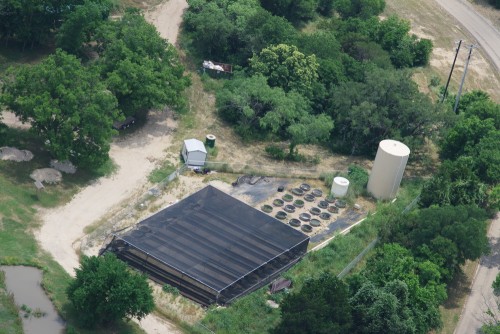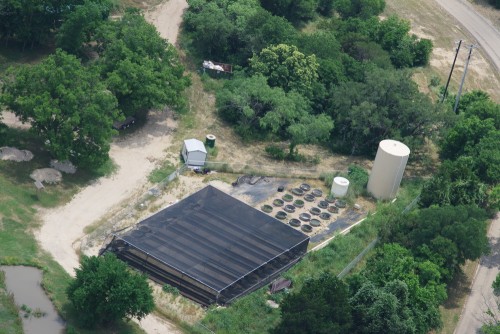BEAR Stream Mesocosm Facility
We are frequently asked about our experimental streams, aka the Baylor Experimental Aquatic Research (BEAR) facility. Below are some general responses to common questions. Please don't hesitate to contact us if you would like to learn more about the BEAR, its role in our research program, and opportunities to pursue future research questions at the facility.
Experimental evidence derived from controlled studies is important for the development of scientifically defensible water quality standards, yet most studies are limited only to field observations from natural lakes, wetlands, and streams because these habitats are too large and complex to manipulate experimentally. The intention of the BEAR facility is to bridge the gap between field observations, which represent the habitat of interest but may be influenced by many interacting chemicals or other aquatic stressors simultaneously, and laboratory or small field experiments, which allow for control of environmental variables yet are too small and unrepresentative of natural conditions to be realistic. Because of its size (over 30,000 square feet), outdoor location, and close proximity to natural aquatic habitats the BEAR facility is a unique, state-of-the-art resource for conducting controlled yet realistic water research studies. Located at the Lake Waco Wetlands, the BEAR features twelve artificial streams and 24 wetland/pond habitats. Also called mesocosms, these units allow Baylor researchers to experimentally manipulate environmental parameters, such concentrations of a chemical known to cause water-quality problems, to test for effects on aquatic organisms and identify critical levels of a pollutant. Moreover, the facility affords great opportunities to conduct basic science to better understand how aquatic organisms interact with their environment.
The BEAR facility is the product a remarkable partnership between the City of Waco and Baylor University, with additional support from the Altria Group, Inc. Both the City and Altria provided tremendous financial support towards construction of the facility, and the City provides ongoing support through their research and education center at the Lake Waco Wetlands.
The BEAR facility will be invaluable to the education and professional training of students at Baylor. Students will serve under the direction of Baylor faculty in conducting experiments, providing them exceptional opportunities to learn through completion of undergraduate and graduate research projects. The facility will also serve to educate the greater Waco community. Visitors will be able to observe science in action and learn about critical water-quality issues that affect us all.
Video of the BEAR streams during March, 2008, following 6 weeks of colonization by periphyton and macroinvertebrates. Streams were "seeded" with organic matter and living organisms from natural streams in our region at the initiation of the colonization period. After just 6 weeks of colonization, we collected over 50 species of macroinvertebrates, thus establishing a natural macroinvertebrate community in a brief period of time. Included in this species list were about 20 stonefly, mayfly and caddisfly taxa, three of the most ecologically sensitive groups found in natural stream ecosystems! In the attached video, take special note of the larval blackflies (Simulium) actively filtering fine particulate organic matter from the water column in the riffles. These streams are indeed living ecosystems!
**Note: if you are unable to view the video from this page, please use this link instead.**
2. What kind of experiments are going on?
Initially, the experimental streams are dedicated to two studies funded by the Altria Group, Inc. and the U. S. Environmental Protection Agency to develop defensible, numerical nutrient criteria for wadeable streams in Texas. This approach relies on an integration of data from real streams with replicated, experimental data generated from the BEAR facility streams. The studies will examine native stream organisms, key indicators of stream health, in response to a wide range of nutrient concentrations in both natural and the experimental streams. The goal is to identify the critical concentrations of nutrients that cause imbalances in the natural assembly of organisms, which will ultimately help develop water-quality criteria that protect aquatic resources in Texas from excessive pollution.
It is anticipated that the BEAR facility will be a tremendous resource for many future studies, including those addressing other common causes of poor water quality in Texas streams such as excessive fine sediment originating from human land uses, as well as emerging contaminants (e.g., antibiotics, hormones), which are also pollutants of concern. We are also interested in water quantity problems and how excessively low-flows caused by water extraction and diversion may impact aquatic life such as fishes in Texas streams.
3. Who is involved/participating in this research?
Several Baylor professors and numerous staff and students are involved at the BEAR facility. Dr Ryan King, Assistant Professor of Biology, is the lead principal investigator of the BEAR streams and is partners with Dr. Bryan Brooks, Associate Professor of Environmental Studies, who is also a principal investigator at the facility. Dr. Robert Doyle, Associate Professor and Chair of Biology, is the lead investigator and developer of the BEAR wetland/pond experimental units.
 |
| Aerial view of the BEAR facility during our first experiment in spring 2008. The facility is covered by an enormous shade-cloth structure to reduce irradiation to levels similar to those found in moderate tree-canopied natural streams in our area. |
4. Who can use the data that are acquired?
The results of BEAR research will be disseminated through peer-reviewed scientific journals and hopefully will impact environmental decision-making. State and federal managers who fund our research will be actively involved in using our data to support developing water-quality criteria and standards. Data from most studies will eventually become available to the public by request through the agencies that funded particular studies following publication in journals.
5. I read about the "polished water" and "riffle, glide and pool sections" of the streams. Can you explain this? Not everyone is familiar with these technical terms.
A key strength of our facility is our source water: The Lake Waco Wetlands. The facility is located within 100 feet of this 80-hectare constructed wetland. However, the water immediately adjacent to the BEAR facility is at the upstream end of the wetland, where water quality is poor because it is pumped directly from the nearby North Bosque River. However, near the outflow of the wetland, the water is extraordinarily clean or "polished" and thus ideal for the experimental facility. Consequently, our site plan included a 500-gallon per minute electrical pump and approximately mile of buried 8" PVC pipe to transport clean water from downstream to a 40,000 gallon water storage tank adjacent to the streams. Water flow is delivered from the 40,000 gal. tank to the streams via a series of 12 valves, each adjusted to regulate flow equivalently among all 12 streams. Before entering the streams, water is pumped into a mixing tank where chemicals representing our experimental treatments (e.g., nutrients) are dosed at a fixed rate using peristaltic pumps connected to a second, adjacent tank of chemical stock solution. Once dosed with the treatment levels of chemicals, water is released into the streams and is discharged back into the Lake Waco Wetlands.
The experimental streams are approximately 2' wide and 60' in length. The streams are stratified into riffle, glide, and pool sections and are designed mimic natural habitat in central Texas streams. A riffle is a high-gradient habitat that is usually fast-flowing, quite shallow, and usually composed of gravel or cobble substrate. Glides are also shallow but usually much slower in water velocity. Pools are deep, slow areas in streams. Each of these habitats tends to support different species with specific adaptations to those particular environments.
Natural cobble, gravel, and sediment substrates are placed in each stream and populated with living organisms from nearby streams, such as algae, bacteria, and aquatic plants and insects. The stream facility utilizes source water that has been "polished" by the natural removal of phosphorus and nitrogen by the 80-hectare wetland. This water is higher in quality than is likely to be found anywhere in the most nearby watersheds, thus providing a unique opportunity to test the effects of a pollutants on the health of stream ecosystems using remarkably clean water as a point of reference under experimentally controlled conditions.
